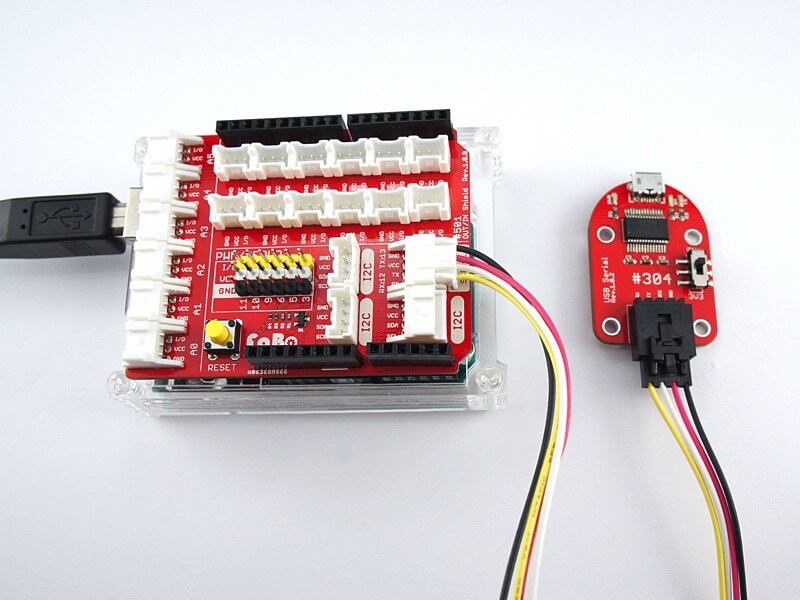#304 USB Serial Brick

Overview
FT232RLを使用した、USBシリアル通信ができるBrickです。
Connecting
Serialコネクタへ接続し、MicroUSBコネクタを他のデバイスに接続します。

Support
| Arduino | RaspberryPI | IchigoJam | NRF51 |
|---|---|---|---|
| ◯ | ◯ | ◯ | ◯ |
FT232RL Datasheet
| Document |
|---|
| FT232RL Datasheet |
Schematic

Sample Code
for Arduino
//
// FaBo Brick Sample
//
// brick_serial_usb
//
#include <SoftwareSerial.h>
int serialusbRx = 12; // RX-I pin Arduino D10
int serialusbTx = 13; // TX-O pin Arduino D11
SoftwareSerial mySerial(serialusbRx, serialusbTx); // RX, TX
void setup()
{
// Open serial communications and wait for port to open:
Serial.begin(9600);
while (!Serial) {
; // wait for serial port to connect. Needed for Leonardo only
}
Serial.println("Goodnight moon!");
// set the data rate for the SoftwareSerial port
mySerial.begin(9600);
}
void loop() // run over and over
{
if (mySerial.available()){
char c = mySerial.read();
Serial.println(c);
}
if (Serial.available())
mySerial.write(Serial.read());
}
for RaspberryPI
# coding: utf-8
#
# FaBo Brick Sample
#
# brick_serial_usb
#
import serial
import time
BLUETOOTH = '/dev/ttyAMA0'
RATE = 115200
if __name__ == '__main__':
count = 0
myserial=serial.Serial(BLUETOOTH, RATE, timeout=1)
while True:
count += 1
myserial.write("send:%d" %count)
str=myserial.readline()
print (str)
MACでのシリアル通信確認
Arduino(またはRaspberryPI)にBrickを接続した状態でPCと接続
ターミナルを起動し、下記のコマンドを実行して接続先の確認
※「/dev/tty.usbserial」で始まるものがBrickになります。sudo ls /dev/tty.*
** ターミナルにて下記のコマンドを実行し、Screenを起動
※「XXXXX」の箇所は上記で確認したものを設定します。
sudo screen /dev/tty.XXXXX 115200
Arduinoを起動し、シリアルモニタを開く
シリアルモニタより文字を入力してEnterキーを押下、またはScreenの画面からキーを入力により文字が送信できることを確認
終了する場合、[Ctrl+A]->[Ctrl+¥]->[Y]の順にキーを押す
NRF51
#include "nrf.h"
#include <stdbool.h>
#include <stdint.h>
#include <stdio.h>
#include "app_uart.h"
#include "app_error.h"
#include "nrf_delay.h"
#define UART_TX_BUF_SIZE 256 /**< UART TX buffer size. */
#define UART_RX_BUF_SIZE 1 /**< UART RX buffer size. */
#define NRF_APP_PRIORITY_HIGH 1
#define FABO_RX 9
#define FABO_TX 11
#define FABO_RTS 0
#define FABO_CTS 0
/**
* @brief UART events handler.
*/
void uart_events_handler(app_uart_evt_t * p_event)
{
switch (p_event->evt_type)
{
case APP_UART_COMMUNICATION_ERROR: APP_ERROR_HANDLER(p_event->data.error_communication);
break;
case APP_UART_FIFO_ERROR: APP_ERROR_HANDLER(p_event->data.error_code);
break;
case APP_UART_TX_EMPTY:
break;
default: break;
}
}
/**
* @brief UART initialization.
*/
void uart_config(void)
{
uint32_t err_code;
const app_uart_comm_params_t comm_params =
{
FABO_RX,
FABO_TX,
FABO_RTS,
FABO_CTS,
APP_UART_FLOW_CONTROL_DISABLED,
false,
UART_BAUDRATE_BAUDRATE_Baud38400
};
APP_UART_FIFO_INIT(&comm_params,
UART_RX_BUF_SIZE,
UART_TX_BUF_SIZE,
uart_events_handler,
APP_IRQ_PRIORITY_LOW,
err_code);
APP_ERROR_CHECK(err_code);
}
/**
* @brief Function for main application entry.
*/
int main(void)
{
uart_config();
printf("\n\rHello Serial.\r\n");
while (true)
{
}
}
NRF52
FaBoのSerialのRX, TXは、NRF52 DKのP0.22,P0.23を参照します。
#include <stdbool.h>
#include <stdint.h>
#include <stdio.h>
#include "app_uart.h"
#include "app_error.h"
#include <string.h>
#define UART_TX_BUF_SIZE 256 /**< UART TX buffer size. */
#define UART_RX_BUF_SIZE 1 /**< UART RX buffer size. */
#define FABO_RX 22
#define FABO_TX 23
#define FABO_CTS 0 // not use
#define FABO_RTS 0 // not use
#ifndef NRF_APP_PRIORITY_HIGH
#define NRF_APP_PRIORITY_HIGH 1
#endif
#define SAMPLES_IN_BUFFER 5
/**
* @brief UART events handler.
*/
void uart_events_handler(app_uart_evt_t * p_event)
{
}
/**
* @brief UART initialization.
*/
void uart_config(void)
{
uint32_t err_code;
const app_uart_comm_params_t comm_params =
{
FABO_RX,
FABO_TX,
FABO_RTS,
FABO_CTS,
APP_UART_FLOW_CONTROL_DISABLED,
false,
UART_BAUDRATE_BAUDRATE_Baud38400
};
APP_UART_FIFO_INIT(&comm_params,
UART_RX_BUF_SIZE,
UART_TX_BUF_SIZE,
uart_events_handler,
APP_IRQ_PRIORITY_LOW,
err_code);
APP_ERROR_CHECK(err_code);
}
/**
* @brief Function for main application entry.
*/
int main(void)
{
uart_config();
printf("\n\rHello Serial.\r\n");
while(true)
{
}
}
Parts
- USB UART IC